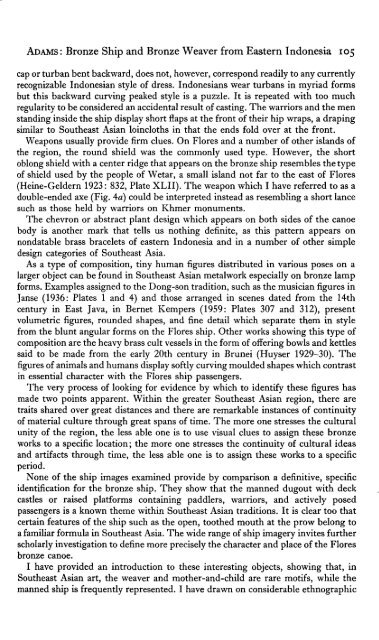A "Forgotten" Bronze Ship and a Recently ... - ScholarSpace
A "Forgotten" Bronze Ship and a Recently ... - ScholarSpace
A "Forgotten" Bronze Ship and a Recently ... - ScholarSpace
You also want an ePaper? Increase the reach of your titles
YUMPU automatically turns print PDFs into web optimized ePapers that Google loves.
ADAMS: <strong>Bronze</strong> <strong>Ship</strong> <strong>and</strong> <strong>Bronze</strong> Weaver from Eastern Indonesia 105<br />
cap or turban bent backward, does not, however, correspond readily to any currently<br />
recognizable Indonesian style of dress. Indonesians wear turbans in myriad forms<br />
but this backward curving peaked style is a puzzle. It is repeated with too much<br />
regularity to be considered an accidental result of casting. The warriors <strong>and</strong> the men<br />
st<strong>and</strong>ing inside the ship display short flaps at the front of their hip wraps, a draping<br />
similar to Southeast Asian loincloths in that the ends fold over at the front.<br />
Weapons usually provide firm clues. On Flores <strong>and</strong> a number of other isl<strong>and</strong>s of<br />
the region, the round shield was the commonly used type. However, the short<br />
oblong shield with a center ridge that appears on the bronze ship resembles thetype<br />
of shield used by the people of Wetar, a small isl<strong>and</strong> not far to the east of Flores<br />
(Heine-Geldern 1923: 832, Plate XLII). The weapon which I have referred to as a<br />
double-ended axe (Fig. 4a) could be interpreted instead as resembling a short lance<br />
such as those held by warriors on Khmer monuments.<br />
The chevron or abstract plant design which appears on both sides of the canoe<br />
body is another mark that tells us nothing definite, as this pattern appears on<br />
nondatable brass bracelets of eastern Indonesia <strong>and</strong> in a number of other simple<br />
design categories of Southeast Asia.<br />
As a type of composition, tiny human figures distributed in various poses on a<br />
larger object can be found in Southeast Asian metalwork especially on bronze lamp<br />
forms. Examples assigned to the Dong-son tradition, such as the musician figures in<br />
Janse (1936: Plates 1 <strong>and</strong> 4) <strong>and</strong> those arranged in scenes dated from the 14th<br />
century in East Java, in Bernet Kempers (1959: Plates 307 <strong>and</strong> 312), present<br />
volumetric figures, rounded shapes, <strong>and</strong> fine detail which separate them in style<br />
from the blunt angular forms on the Flores ship. Other works showing this type of<br />
composition are the heavy brass cult vessels in the form of offering bowls <strong>and</strong> kettles<br />
said to be made from the early 20th century in Brunei (Huyser 1929-30). The<br />
figures of animals <strong>and</strong> humans display softly curving moulded shapes which contrast<br />
in essential character with the Flores ship passengers.<br />
The very process of looking for evidence by which to identify these figures has<br />
made two points apparent. Within the greater Southeast Asian region, there are<br />
traits shared over great distances <strong>and</strong> there are remarkable instances of continuity<br />
of material culture through great spans of time. The more one stresses the cultural<br />
unity of the region, the less able one is to use visual clues to assign these bronze<br />
works to a specific location; the more one stresses the continuity of cultural ideas<br />
<strong>and</strong> artifacts through time, the less able one is to assign these works to a specific<br />
period.<br />
None of the ship images examined provide by comparison a definitive, specific<br />
identification for the bronze ship. They show that the manned dugout with deck<br />
castles or raised platforms containing paddlers, warriors, <strong>and</strong> actively posed<br />
passengers is a known theme within Southeast Asian traditions. It is clear too that<br />
certain features of the ship such as the open, toothed mouth at the prow belong to<br />
a familiar formula in Southeast Asia. The wide range of ship imagery invites further<br />
scholarly investigation to define more precisely the character <strong>and</strong> place of the Flores<br />
bronze canoe.<br />
I have provided an introduction to these interesting objects, showing that, in<br />
Southeast Asian art, the weaver <strong>and</strong> mother-<strong>and</strong>-child are rare motifs, while the<br />
manned ship is frequently represented. I have drawn on considerable ethnographic
















